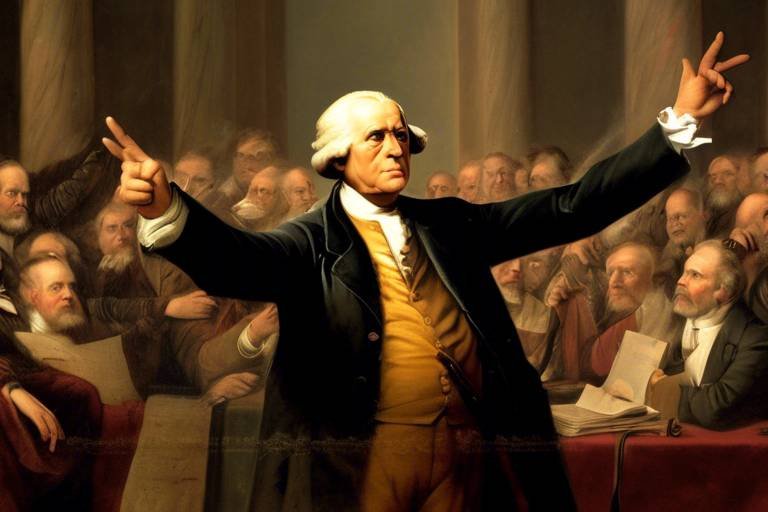The Philosophy of Human Sexuality
The exploration of human sexuality is not just a biological or psychological phenomenon; it is a complex tapestry woven with threads of philosophical inquiry, cultural narratives, and ethical considerations. When we delve into the philosophy of human sexuality, we uncover layers of meaning that extend beyond mere physical attraction or reproductive necessity. It's about understanding the very essence of what it means to be human in a world where sexual expression is often both celebrated and stigmatized. The interplay between desire and identity becomes a focal point, as individuals navigate their sexual orientations and preferences within the broader context of societal expectations.
At its core, the philosophy of human sexuality challenges us to question not just how we engage in sexual relationships, but why we do so. It invites us to reflect on the motivations that drive our desires and the implications of those desires on our identities. Are we shaped by our biological instincts, or do cultural and social constructs play a more significant role in defining our sexual behaviors? This inquiry leads to a deeper understanding of the ethical dimensions of sexual conduct, prompting us to consider the moral responsibilities we hold toward ourselves and others in our intimate interactions.
Moreover, the philosophy of human sexuality encourages an examination of the historical context that has shaped our current views. From ancient civilizations that celebrated sexual freedom to contemporary societies grappling with issues of consent and autonomy, the evolution of sexual norms reveals much about human nature. It's fascinating to see how different eras and cultures have influenced our understanding of sexuality, often reflecting broader societal changes and shifts in power dynamics. This historical lens not only enriches our comprehension of current sexual ethics but also highlights the ongoing debates surrounding sexual rights and freedoms.
As we navigate this philosophical landscape, we must also consider the impact of cultural narratives on our sexual identities. Each culture brings its own set of beliefs, taboos, and practices that inform how sexuality is expressed and understood. This cultural diversity is a vital aspect of the human experience, reminding us that there is no singular way to approach sexuality. Instead, we are presented with a mosaic of perspectives that can either liberate or constrain individual expression.
In this context, the philosophy of human sexuality is not merely an academic exercise; it is a vital discourse that resonates with our everyday lives. It compels us to engage with questions of autonomy, consent, and identity, urging us to create a more inclusive and understanding society. As we continue to explore these profound themes, we find that the journey through the philosophy of human sexuality is as enriching as it is challenging, offering insights that can lead to greater empathy and connection among individuals.
- What is the philosophy of human sexuality?
The philosophy of human sexuality examines the ethical, cultural, and personal dimensions of sexual behavior and identity.
- Why is consent important in sexual relationships?
Consent is crucial as it establishes mutual respect and understanding, ensuring that all parties feel safe and valued in their interactions.
- How do cultural norms influence sexuality?
Cultural norms shape our beliefs and practices regarding sexuality, impacting everything from sexual expression to the acceptance of different identities.
- Can sexuality be understood through history?
Yes, historical contexts reveal how societal changes have influenced sexual norms and ethics, providing a deeper understanding of contemporary views.

The Historical Context of Sexuality
Understanding the evolution of sexual norms throughout history sheds light on contemporary views, revealing how societal changes have shaped our understanding of human sexuality. From ancient civilizations to modern societies, the perception of sexuality has undergone a profound transformation influenced by cultural, religious, and political factors. For instance, in ancient Greece, sexuality was often celebrated and openly discussed, with a focus on the beauty of the human body and erotic relationships. This contrasts sharply with the more conservative views that emerged during the Middle Ages, where sexuality was frequently associated with sin and repression.
As we move through history, we see how the Victorian era brought about a period of strict moral codes, where discussions of sexuality were often shrouded in shame and secrecy. The societal norms dictated that sexual expression should be confined to marriage, and any deviation was met with harsh judgment. However, the 20th century marked a significant turning point, as movements advocating for sexual liberation began to challenge these restrictive norms. The sexual revolution of the 1960s and 70s encouraged individuals to explore their sexuality freely, leading to a more open and accepting discourse around sexual identity.
Moreover, the impact of the feminist movement cannot be overstated. It played a crucial role in redefining sexual agency and autonomy, emphasizing the importance of consent and the right to sexual pleasure. This shift in perspective has paved the way for ongoing discussions about sexual rights and equality, which continue to evolve today. To better illustrate this historical context, let’s take a look at a simplified timeline of key events that have shaped our understanding of sexuality:
| Era | Key Developments |
|---|---|
| Ancient Civilizations | Open discussions of sexuality; celebration of erotic relationships |
| Middle Ages | Repression of sexuality; association with sin |
| Victorian Era | Strict moral codes; sexuality confined to marriage |
| 1960s-70s | Sexual revolution; advocacy for sexual liberation |
| Present Day | Ongoing discussions about sexual rights and equality |
As we reflect on these historical shifts, it becomes evident that our current understanding of sexuality is not just a matter of personal preference but is deeply embedded in a complex tapestry of cultural narratives. The interplay between societal norms and individual desires continues to shape how we view sexuality today. Are we truly free to express our desires, or are we still bound by the chains of historical context? This question invites us to explore further, as we navigate the intricate landscape of human sexuality.

Ethics and Morality in Sexual Behavior
When we dive into the murky waters of ethics and morality in sexual behavior, we uncover a landscape rich with complexity and nuance. The way we approach sexual conduct is not just a matter of personal choice; it is interwoven with societal norms, cultural expectations, and philosophical debates. What does it mean to engage in sexual activity ethically? How do we navigate the often gray areas of consent and autonomy? These questions are pivotal in understanding the moral framework that governs our intimate lives.
At the heart of ethical sexual interactions lies the concept of consent. Consent is not merely a checkbox to be ticked; it is a dynamic and ongoing conversation between partners. The importance of consent cannot be overstated—it is the bedrock upon which all ethical sexual encounters are built. Without it, the very essence of a healthy relationship crumbles. Imagine trying to build a house on quicksand; that’s what relationships without consent are like. They lack stability and are prone to collapse under pressure.
Consent is an evolving concept, often debated among philosophers and ethicists. It raises numerous questions: What constitutes valid consent? Can consent be revoked? How do power dynamics affect the ability to give or withdraw consent? These questions are not just academic; they have real-world implications. In an age where discussions around sexual misconduct are front and center, understanding consent is more crucial than ever.
Informed consent takes the conversation a step further. It emphasizes that both parties must not only agree to engage in sexual activity but also fully understand what that entails. Think of it like signing a contract; you wouldn’t sign a contract without reading the fine print, would you? Informed consent ensures that individuals are aware of the risks, boundaries, and expectations involved in their interactions. This understanding fosters a sense of respect and responsibility, promoting healthier, more fulfilling relationships.
However, consent is not a universal concept; it varies significantly across cultures. In some societies, traditional norms may dictate how consent is viewed and practiced. For instance, in certain cultures, family approval may play a substantial role in the consent process, while in others, individual autonomy is prioritized. This cultural lens complicates the ethical landscape of sexual behavior. It challenges us to consider how our own cultural biases shape our understanding of consent and, ultimately, our ethical positions.
As we explore these cultural differences, it becomes evident that a one-size-fits-all approach to ethics in sexual behavior is inadequate. The implications of these variations are profound, influencing everything from legal frameworks to personal relationships. Understanding these differences can help foster a more nuanced dialogue about sexuality, one that respects diverse perspectives while advocating for fundamental human rights.
Sexual identity and expression are also intertwined with ethics and morality. How we identify and express our sexuality can be a source of joy and empowerment, but it can also lead to ethical dilemmas. For instance, when societal norms clash with personal identity, individuals may find themselves navigating a minefield of moral questions. Is it ethical to suppress one's identity to conform to societal expectations? Or is it more ethical to live authentically, even at the risk of societal backlash? These dilemmas are not just theoretical; they are lived experiences for many.
Ultimately, the ethics of sexual behavior are about respect—respect for oneself and respect for others. It’s about fostering relationships built on trust, communication, and understanding. As we continue to explore these themes, we must remain open to the complexities involved, recognizing that our moral compass may need recalibration as we learn and grow.
- What is the importance of consent in sexual relationships?
Consent is crucial as it ensures that both parties agree to engage in sexual activity, fostering respect and understanding. - How does culture influence sexual ethics?
Cultural norms can shape perceptions of consent and morality, leading to varying practices and beliefs regarding sexual behavior. - What is informed consent?
Informed consent means that individuals fully understand and agree to the terms of their sexual interactions, including risks and boundaries. - Why is sexual identity important in discussions of ethics?
Sexual identity plays a significant role in how individuals navigate their relationships and societal expectations, raising important ethical questions about authenticity and acceptance.

The Role of Consent
Consent is not just a buzzword; it’s the very foundation of ethical sexual interactions. Imagine stepping into a dance hall where everyone is moving to the rhythm of mutual respect and understanding. In this space, consent is the music that guides the movements. It’s about more than just saying “yes” or “no”; it’s about communication, understanding, and mutual agreement. Without it, the dance can quickly turn into chaos, leading to misunderstandings and violations of personal boundaries.
At its core, consent is about autonomy. It acknowledges that each individual has the right to make decisions about their own body and sexual experiences. However, the conversations around consent can often become tangled in complex philosophical debates. For instance, what happens when someone feels pressured to say “yes”? Is that truly consent? This question opens up a myriad of discussions about power dynamics, societal expectations, and personal agency. In essence, consent should be a clear, enthusiastic, and ongoing agreement between all parties involved.
One of the most critical aspects of consent is the concept of informed consent. This means that all parties must not only agree to engage in a sexual act but also fully understand what that entails. Think of it like signing a contract before starting a business deal. You wouldn’t want to enter into an agreement without knowing all the terms, right? Informed consent emphasizes the necessity of clarity and transparency, ensuring that individuals are aware of their rights and the potential consequences of their actions.
Furthermore, consent is not a one-time checkbox; it must be ongoing. Just as a conversation evolves, so too can the dynamics of consent in a sexual relationship. It’s crucial to check in with your partner regularly, ensuring that both parties are comfortable and willing to continue. This ongoing dialogue fosters a healthier relationship and creates an atmosphere of trust and respect.
Now, let’s take a look at how cultural perspectives influence the understanding of consent. Different cultures have varying norms and practices regarding consent, which can significantly impact how sexual relations are navigated. For instance, in some cultures, traditional practices may prioritize familial or societal expectations over individual autonomy. This can create a complex landscape where the definition of consent can differ drastically. Understanding these cultural nuances is essential for fostering respectful and ethical sexual interactions across diverse backgrounds.
In conclusion, consent is a multifaceted concept that plays a pivotal role in shaping ethical sexual behavior. It’s about respect, understanding, and ongoing communication. As we continue to navigate the complexities of human sexuality, let’s remember that consent is not just a legal necessity but a fundamental aspect of human dignity and personal autonomy.
- What is the difference between consent and informed consent? Consent is the agreement to engage in a sexual act, while informed consent means that all parties understand the implications of their agreement.
- Can consent be withdrawn? Yes, consent can be withdrawn at any time, and it’s essential to respect that decision immediately.
- How does culture affect the understanding of consent? Different cultures have unique norms and values that shape their understanding and practices regarding consent, which can lead to varying definitions and expectations.

Informed Consent
Informed consent is like the golden key to ethical sexual interactions; it unlocks the door to mutual respect and understanding between partners. Imagine embarking on a thrilling adventure—wouldn't you want to know all the details before diving in? Informed consent ensures that both parties are fully aware of what they are getting into, allowing for a more enriching and safe experience. It’s not just about saying “yes” or “no,” but about having a deep understanding of the implications and responsibilities that come with sexual encounters. This concept is vital in protecting individual rights and promoting healthy relationships, as it fosters an environment where open communication and trust can flourish.
The essence of informed consent lies in three fundamental principles: awareness, agreement, and autonomy. Awareness means that individuals should have all the necessary information regarding the sexual activity in question—this includes understanding the risks involved, the nature of the relationship, and any emotional or physical implications. Agreement goes beyond mere verbal acknowledgment; it requires that the decision to engage in sexual activity is made freely, without coercion or manipulation. Autonomy emphasizes the importance of individual choice, allowing each person to express their desires and boundaries without fear of judgment.
To illustrate the importance of informed consent, consider the following scenarios:
- Scenario A: Two partners discuss their boundaries and preferences before engaging in sexual activity, ensuring both feel comfortable and respected.
- Scenario B: One partner pressures the other into a sexual act without fully disclosing potential risks or consequences, leading to feelings of regret and violation.
Moreover, informed consent is not static; it can evolve during the course of a relationship. Just as a plant needs water and sunlight to grow, consent requires ongoing communication. Partners should feel empowered to revisit their consent at any time, especially if circumstances change. This fluidity acknowledges that desires and boundaries can shift, making it essential for partners to remain attuned to each other's feelings and needs.
Informed consent also varies across different cultures, which can complicate its application. In some societies, discussions about sexual consent may be less open or even taboo, leading to misunderstandings and potential violations of personal autonomy. Thus, it’s essential to approach the topic with cultural sensitivity, recognizing that what constitutes informed consent can differ widely. Understanding these cultural nuances can help create a more inclusive dialogue about sexual ethics.
In conclusion, informed consent is a cornerstone of ethical sexual interactions. It empowers individuals to engage in relationships that are respectful, consensual, and fulfilling. By fostering an environment of open communication and mutual understanding, we can create a society where everyone feels safe and valued in their sexual experiences.
- What is informed consent? Informed consent is the process of ensuring that all parties involved in a sexual encounter fully understand and agree to the terms and implications of the activity.
- Why is informed consent important? It protects individual rights, promotes healthy relationships, and fosters an environment of trust and respect between partners.
- Can consent change over time? Yes, consent is fluid and can change based on circumstances, feelings, and communication between partners.
- How can I ensure that I have informed consent? Engage in open discussions with your partner about boundaries, preferences, and potential risks, and ensure that both parties feel comfortable and respected.

Consent in Different Cultures
When we delve into the concept of consent, it's essential to recognize that this foundational principle does not exist in a vacuum. Instead, it is intricately woven into the fabric of cultural contexts, each with its own set of beliefs, practices, and values that shape how consent is understood and enacted. For instance, in many Western societies, the emphasis is placed heavily on individual autonomy and the explicit communication of consent. This means that a clear, affirmative agreement is often required before any sexual activity can take place. However, this understanding is not universal.
In contrast, some cultures may prioritize communal values over individual desires, leading to different interpretations of what consent entails. In certain traditional societies, consent might be viewed through the lens of familial or societal approval rather than personal agreement. For example, arranged marriages, which are still prevalent in various cultures, often involve negotiations between families rather than the individuals directly involved. This raises questions about the nature of consent and whether it can truly be considered 'informed' when it is mediated by familial expectations.
Additionally, the concept of consent can also vary significantly within the same culture based on factors such as gender, social class, and age. In many cultures, women may have less agency in expressing their consent, often due to deeply ingrained patriarchal norms. This can lead to situations where consent is assumed rather than explicitly given, which complicates the ethical landscape of sexual interactions. For instance, a woman might feel pressured to consent to a relationship or sexual encounter due to societal expectations or fear of stigma, which challenges the very essence of what it means to give consent freely.
The implications of these cultural differences are profound. They not only affect interpersonal relationships but also influence legal frameworks and policies regarding sexual conduct. In some countries, laws regarding consent may not align with the cultural understanding of the term, leading to significant disparities in the protection of individuals' rights. For instance, the age of consent varies widely around the world, reflecting differing cultural attitudes toward maturity and sexual agency.
To illustrate these differences more clearly, consider the following table that outlines varying cultural perspectives on consent:
| Culture | Understanding of Consent | Key Factors Influencing Consent |
|---|---|---|
| Western Cultures | Emphasis on explicit, informed consent | Individual autonomy, legal frameworks |
| Middle Eastern Cultures | Family approval often prioritized | Familial expectations, social norms |
| Indigenous Cultures | Community-based understanding | Collective values, traditions |
| Asian Cultures | Varied; often influenced by hierarchy | Gender roles, social class |
As we navigate the complexities of consent across cultures, it becomes clear that understanding and respecting these differences is crucial for fostering healthy, ethical sexual relationships. Engaging in open dialogues about consent that consider cultural nuances can lead to more informed and compassionate interactions. It's about finding a balance between respecting cultural practices while advocating for the fundamental right of every individual to have their consent recognized and valued.
- What is the definition of consent? Consent is an agreement between participants to engage in sexual activity, which must be given freely, enthusiastically, and can be revoked at any time.
- How does culture influence consent? Different cultures have varying norms and values that shape how consent is understood, communicated, and practiced.
- Can consent be implied? While some cultures may allow for implied consent based on social cues, explicit consent is generally considered the safest and most ethical approach.
- What are the consequences of ignoring consent? Ignoring consent can lead to serious ethical and legal repercussions, including emotional trauma and criminal charges.

Sexual Identity and Expression
Understanding sexual identity is akin to peeling an onion; each layer reveals a deeper complexity that shapes who we are. Sexual identity is not just about who we are attracted to; it encompasses a broad spectrum of experiences and expressions that define our place in the world. In a society that is increasingly recognizing the fluidity of sexuality, it's crucial to examine how individuals navigate their identities amidst cultural expectations and personal experiences.
At its core, sexual identity is influenced by a myriad of factors, including biological, psychological, and social elements. From the moment we begin to explore our feelings and attractions, we engage in a journey of self-discovery that can be both liberating and challenging. This journey often involves questioning societal norms and grappling with the expectations imposed by family, friends, and culture at large. For many, this process can lead to a profound understanding of their authentic selves.
One of the most significant aspects of sexual identity is the concept of sexual orientation. This term encompasses the patterns of emotional, romantic, or sexual attraction one feels towards others. It is essential to recognize that sexual orientation is not a binary concept; it exists on a spectrum. For example, some individuals may identify as heterosexual, while others may identify as homosexual, bisexual, pansexual, or asexual, among other identities. Each identity carries its own unique experiences and challenges, which can be influenced by cultural and societal contexts.
Moreover, sexual expression—the way individuals communicate their sexuality—plays a critical role in shaping sexual identity. This expression can manifest in various forms, such as through relationships, behaviors, or even personal style. The freedom to express one's sexuality authentically is vital for mental and emotional well-being. However, not everyone has the privilege to express their identity openly. In some cultures, expressing one's sexual identity can lead to stigmatization or persecution, which can have profound psychological effects.
To further illustrate the diversity of sexual identities, consider the following table that outlines some common identities and their definitions:
| Identity | Description |
|---|---|
| Heterosexual | Attraction to individuals of the opposite gender. |
| Homosexual | Attraction to individuals of the same gender. |
| Bisexual | Attraction to individuals of both genders. |
| Pansexual | Attraction regardless of gender; includes non-binary individuals. |
| Asexual | Lack of sexual attraction to others. |
As society evolves, so does the language surrounding sexual identity. Terms that were once considered taboo are now part of everyday conversations, fostering a more inclusive environment. This shift is not just about acceptance; it’s about celebrating diversity and understanding the rich tapestry of human experiences. The more we learn about different sexual identities, the more we can empathize with others and appreciate the complexities of their journeys.
In conclusion, sexual identity and expression are deeply personal yet universally significant. They remind us that while we may have different experiences, the quest for understanding and acceptance is a common thread that binds us all. As we continue to navigate this intricate landscape, let’s strive to create spaces where everyone can feel free to express their true selves without fear of judgment or discrimination.
- What is sexual identity? Sexual identity refers to how individuals perceive themselves in relation to their sexual orientation, preferences, and expressions.
- Why is consent important in sexual relationships? Consent is crucial as it ensures that all parties involved agree to participate in sexual activities, promoting respect and autonomy.
- How do cultural factors influence sexual identity? Cultural norms can shape perceptions of sexuality, influencing how individuals express their identities and navigate societal expectations.
- Can sexual identity change over time? Yes, sexual identity can be fluid, and individuals may find that their attractions and preferences evolve throughout their lives.

The Impact of Culture on Sexuality
Culture is a powerful force that shapes our understanding and expression of sexuality. It acts like a lens through which we view sexual norms, behaviors, and identities. Whether we are aware of it or not, our cultural background influences our beliefs about what is acceptable in sexual relationships. This influence can manifest in various ways, from the rituals we participate in to the language we use when discussing intimacy. For instance, in some cultures, open expressions of love and sexuality are celebrated, while in others, they may be considered taboo. This dichotomy raises important questions: How do cultural narratives around sexuality shape individual experiences? And what are the implications of these narratives on broader societal norms?
To understand the impact of culture on sexuality, we must first recognize that cultural norms are not monolithic. They vary widely, even within the same geographical region. For example, in Western societies, there has been a significant shift towards more liberal views on sexuality over the past few decades, influenced by movements advocating for LGBTQ+ rights and sexual liberation. In contrast, many traditional societies may still adhere to conservative views that emphasize chastity and heterosexual relationships as the norm. This cultural clash can create tension and confusion for individuals navigating their sexual identities.
Moreover, cultural practices surrounding sexuality often intersect with issues of power and identity. In some cultures, sexual expression is tied to social status, gender roles, and even economic conditions. For instance, the concept of virginity is often imbued with various meanings depending on cultural context. In certain societies, a woman’s virginity may be viewed as a commodity, impacting her worth and status within the community. On the other hand, in more egalitarian cultures, the emphasis may shift towards mutual consent and personal agency, allowing individuals to define their sexual experiences more freely.
Another important aspect to consider is how cultural narratives are perpetuated through various mediums, particularly media. The representation of sexuality in films, television shows, and advertisements can have profound effects on societal attitudes. For example, when media portrays diverse sexual orientations and relationships positively, it can help normalize those experiences, fostering acceptance and understanding. Conversely, negative or stereotypical representations can reinforce harmful biases and stigmas, affecting how individuals perceive themselves and their sexuality.
In summary, culture plays a pivotal role in shaping our understanding of sexuality. It influences everything from our beliefs about relationships to the language we use to describe our desires. As we navigate our own sexual identities, it's essential to recognize these cultural influences and consider how they impact our experiences. By fostering open conversations about sexuality across different cultures, we can work towards a more inclusive understanding that honors the diversity of human experiences.
- How does culture shape our understanding of consent?
Culture influences what is considered acceptable behavior in sexual relationships, including how consent is communicated and understood. Different cultures may have varying norms regarding expressing agreement or disagreement in sexual contexts. - What role does media play in shaping sexual norms?
Media representations can either challenge or reinforce cultural narratives about sexuality. Positive portrayals of diverse sexual identities can promote acceptance, while negative stereotypes can perpetuate stigma. - Are there universal sexual norms?
While some aspects of sexuality may be universally recognized, such as the importance of consent, the specific norms and values surrounding sexual behavior vary widely across different cultures.

Sexual Norms Across Cultures
When we dive into the realm of , we uncover a rich tapestry woven from threads of history, tradition, and social values. Each culture has its own unique set of beliefs and practices that dictate what is considered acceptable or taboo in the realm of sexuality. For instance, in many Western societies, sexual freedom and expression are often celebrated, while in others, such as certain conservative communities, sexual behavior may be tightly regulated and viewed through a lens of strict morality. This divergence raises the question: how do these cultural frameworks shape our understanding of sexuality?
One fascinating aspect of sexual norms is how they can be both fluid and rigid. In some cultures, sexual practices are highly codified, with explicit rules governing behavior. For example, in many Middle Eastern cultures, premarital sex is often frowned upon, and arranged marriages are common, reflecting a collective belief in the importance of family and social order. Conversely, in cultures like those found in parts of Scandinavia, there is a strong emphasis on individual autonomy and sexual freedom, leading to more liberal attitudes toward premarital sex and diverse sexual orientations.
To illustrate these differences, consider the following table that outlines various cultural attitudes towards key aspects of sexuality:
| Culture | Attitude Towards Premarital Sex | View on LGBTQ+ Relationships | Importance of Consent |
|---|---|---|---|
| Middle Eastern | Generally prohibited | Often stigmatized | Highly emphasized |
| Scandinavian | Generally accepted | Widely accepted | Fundamental |
| South Asian | Varies by region | Generally stigmatized | Growing emphasis |
| Western European | Generally accepted | Widely accepted | Fundamental |
As we can see from the table, the attitudes toward premarital sex and LGBTQ+ relationships vary significantly across cultures. These differences not only reflect the values of each society but also influence individual behaviors and choices. For instance, in cultures where premarital sex is accepted, individuals may feel more liberated to explore their sexuality without fear of social repercussions. In contrast, those in more conservative cultures may experience internal conflict or shame when navigating their sexual desires.
Moreover, the importance of consent is a universal theme, yet its interpretation can differ vastly. In many progressive societies, consent is viewed as a cornerstone of sexual ethics, emphasizing the need for mutual agreement and understanding in sexual encounters. However, in cultures where traditional gender roles are predominant, the concept of consent may be interpreted differently, often leading to misunderstandings and ethical dilemmas.
Ultimately, the exploration of sexual norms across cultures reveals not just a variety of practices but also a deeper understanding of human behavior and societal values. It invites us to reflect on our own beliefs and consider how they might be shaped by cultural influences. Are we open to embracing the diversity of sexual expression, or do we cling to our own cultural narratives? This reflection is crucial as we navigate an increasingly globalized world, where cross-cultural interactions are more common than ever.
- What are sexual norms? Sexual norms are the accepted behaviors and beliefs regarding sexuality within a particular culture or society.
- How do cultural attitudes towards sexuality impact individuals? Cultural attitudes can shape personal beliefs, influence behavior, and affect how individuals express their sexuality.
- Why is consent important in sexual relationships? Consent is crucial as it ensures that all parties involved in a sexual encounter agree to participate, promoting respect and safety.
- How do different cultures view LGBTQ+ relationships? Views on LGBTQ+ relationships vary widely, with some cultures being accepting while others may stigmatize or criminalize such relationships.

The Influence of Media on Sexual Perception
The media serves as a powerful lens through which we view the world, and when it comes to sexuality, its influence is profound and far-reaching. From television shows and movies to social media platforms and advertising, the messages conveyed about sex and relationships can shape societal norms and individual attitudes. Have you ever stopped to think about how the characters you see on screen or the images that flash before your eyes influence your perceptions of what is considered "normal" in sexual behavior? It's fascinating to consider how these representations can both reflect and distort reality.
One of the most significant impacts of media on sexual perception is the way it normalizes behaviors that may not align with real-life experiences. For example, romantic comedies often portray idealized versions of relationships, where sexual encounters are depicted as effortless and devoid of complications. This can lead to unrealistic expectations for individuals navigating their own intimate lives. In contrast, dramas may sensationalize sexual encounters, emphasizing danger or taboo, which can instill fear or anxiety around sexual expression.
Moreover, the portrayal of gender roles in media can heavily influence how individuals perceive their own sexual identities and behaviors. Traditional media often reinforces stereotypes, where men are depicted as aggressive and sexually dominant, while women are shown as passive or submissive. This kind of representation can create a skewed understanding of consent and desire, leading to harmful societal norms. For instance, the idea that 'no means yes' can stem from these pervasive stereotypes, highlighting the urgent need for more responsible media portrayals.
To illustrate the impact of media on sexual perception, consider the following table that outlines key findings from studies examining media influence on sexual attitudes:
| Study | Findings |
|---|---|
| Smith et al. (2020) | Increased exposure to sexual content in media correlates with more permissive sexual attitudes among adolescents. |
| Johnson & Lee (2019) | Women who consume media with strong sexual stereotypes report lower self-esteem and body image issues. |
| Garcia (2021) | Media representations of LGBTQ+ relationships have improved, leading to greater acceptance and understanding in society. |
As we navigate this media-saturated environment, it’s essential to cultivate a critical eye. Engaging with media thoughtfully can help individuals discern between entertaining fiction and the complexities of real-life sexual relationships. Conversations around media literacy can empower people to question and challenge the narratives they consume, fostering a healthier understanding of sexuality.
In addition, social media has introduced new dynamics to sexual perception. Platforms like Instagram and TikTok often showcase curated lifestyles that may glamorize certain aspects of sexuality while omitting the emotional and relational intricacies involved. Influencers can play a role in shaping sexual norms, but their portrayals often lack depth and can perpetuate unrealistic standards. This begs the question: how can we balance the allure of social media with the need for authentic representation of sexuality?
Ultimately, the influence of media on sexual perception is a double-edged sword. While it offers opportunities for education and representation, it also poses risks of misrepresentation and unrealistic expectations. As consumers of media, we hold the power to challenge these narratives and advocate for more nuanced and responsible portrayals of sexuality. By doing so, we can contribute to a culture that embraces diversity, promotes healthy relationships, and respects individual autonomy.
- How does media influence sexual behavior?
Media can shape perceptions of what is normal or acceptable in sexual behavior, often leading to unrealistic expectations. - Are there positive representations of sexuality in media?
Yes, there are increasingly diverse and positive portrayals of sexuality, particularly in independent films and online platforms. - What can I do to critically engage with media?
Practice media literacy by questioning the messages you consume and discussing them with others to gain different perspectives.
Frequently Asked Questions
- What is the significance of consent in sexual relationships?
Consent is the cornerstone of ethical sexual interactions. It ensures that all parties involved are fully aware and agree to engage in a sexual activity. Without consent, the dynamics of a relationship can shift dramatically, leading to ethical dilemmas and potential harm. It's not just about saying "yes" or "no," but about understanding and respecting boundaries.
- How have historical contexts shaped modern views on sexuality?
Throughout history, societal norms regarding sexuality have evolved significantly. From ancient civilizations that celebrated sexual expression to more conservative eras that imposed strict regulations, these shifts have influenced contemporary attitudes. Understanding this evolution helps us appreciate the complexities of human sexuality today.
- What role does culture play in shaping sexual norms?
Cultural influences are pivotal in defining what is considered acceptable sexual behavior. Different societies have unique practices, taboos, and beliefs surrounding sexuality, which can vary widely. These cultural norms not only dictate individual behavior but also impact broader societal attitudes towards sexuality.
- How does informed consent differ across cultures?
Informed consent is a universal concept, but its interpretation can vary significantly between cultures. Some cultures may prioritize communal values over individual autonomy, affecting how consent is understood and practiced. This diversity highlights the need for sensitivity and understanding in cross-cultural discussions about sexual ethics.
- What impact does media have on our perception of sexuality?
Media plays a crucial role in shaping societal views on sexuality. From movies and television shows to social media platforms, representations of sexual behavior can influence public attitudes and personal beliefs. The way sexuality is portrayed can either challenge stereotypes or reinforce harmful norms.
- Why is understanding sexual identity important?
Understanding sexual identity is essential for recognizing the diverse ways individuals express their sexuality. It helps foster acceptance and respect for different identities, promoting a more inclusive society. Moreover, exploring sexual identity can lead to deeper insights into personal experiences and social dynamics.



















